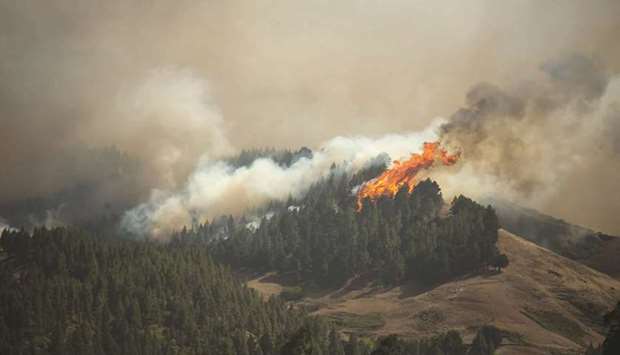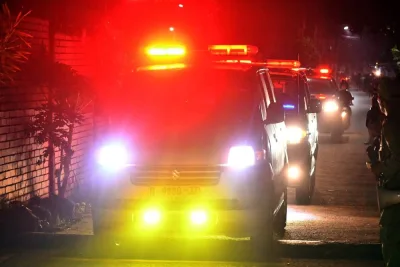A fire raged out of control on the Spanish holiday island of Gran Canaria yesterday, forcing evacuations as flames rose so high even water-dropping planes could not operate in what was dubbed an “environmental tragedy”.
The blaze, the third in 10 days in the mountainous centre of the island, has forced the evacuation of several villages with a combined population of 9,000, a spokeswoman for the emergency services said.
The exact number of evacuees was unclear on the island that lies at the heart of the Canary archipelago off the coast of northwest Africa.
No fatalities have been reported and tourism on Gran Canaria, which boasts breathtaking views and is popular with foreigners, had not been affected.
“This is an environmental tragedy,” Canary Islands President Angel Victor Torres told reporters.
Torres said that the hot summer weather and low humidity made it difficult to get a handle on the “extremely aggressive” blaze.
On Sunday alone 800,000 litres of water were used on the fire.
Videos showed firefighters with large hoses running through the burning woods trying to douse the flames.
Altogether, 1,000 firefighters and other crew and 14 water-dropping helicopters and planes were working on controlling the blaze, which has destroyed 6,000 hectares (15,000 acres), according to emergency services.
This deployment “is the biggest ever carried out in the Canaries and one of the biggest implemented in Spain in the past few years”, said Agriculture Minister Luis Planas.
So fierce is the fire in what is part of a Unesco biosphere reserve that in some areas, it “is beyond our (extinguishing) capacities”, Federico Grillo, head of emergency services in Gran Canaria, said late on Sunday.
On the northwestern flank of the blaze, flames have risen as high as 50m (160’), preventing ground crew or water-dropping aircraft from approaching, the emergency services spokeswoman said.
She added around 100 people had been “confined” to the cultural centre of Artenara, unable to leave this village in the disaster zone as all possible evacuation roads were too dangerous.
Environment Minister Planas said the next 48 hours would be “critical”.
The fire broke out on Saturday, just days after another wildfire in the same region forced the evacuation of hundreds.
Lourdes Hernandez, an expert on wildfires at WWF, told AFP that the blaze had entered the Tamadaba natural park, an untouched pine forest that represents “the main green lungs of the island”.
The fire is also threatening the Inagua nature reserve, another area of major biodiversity.
“Tamadaba is lost, we can’t enter,” firefighter chief Carlos Velazquez told reporters. “When (weather) conditions begin to change that it when we can begin to control the fire.”
Two other fires hit the island’s centre last week without causing injury.
Hernandez said scientists blamed the rapid propagation of the blazes to climate change, even if fires are often initially triggered by humans, both intentionally or not.
“The virulence of the fire, the speed at which flames spread, the intensity of the fronts, mean that more extreme weather conditions are generated inside the fire and embers leap sometimes hundreds of metres away,” she said.
“That’s what is known as firestorms. And they’re blazes that cannot be approached and cannot be extinguished” by firefighting forces.
The centre of the island, with its valleys, slopes and mountains offering breath-taking views, attracts hikers.
But a large majority of tourists who visit Gran Canaria, the second-most populous of the Canary Islands, stay in beach resorts.
In a statement, the Canary Islands government said the tourism industry on Gran Canaria remained unaffected “given that the fire is confined to upland areas”, with no resorts impacted and no flight delays.
Torres said the “maximum priority” was to “preserve human lives”.
With its arid hot summers, Spain is frequently plagued by huge forest fires.
The Canary Islands received 13.7mn foreign visitors last year, over half of them from Britain and Germany.

Flames rise from a forest fire raging in Monta?a Alta, on the island of Gran Canaria.


